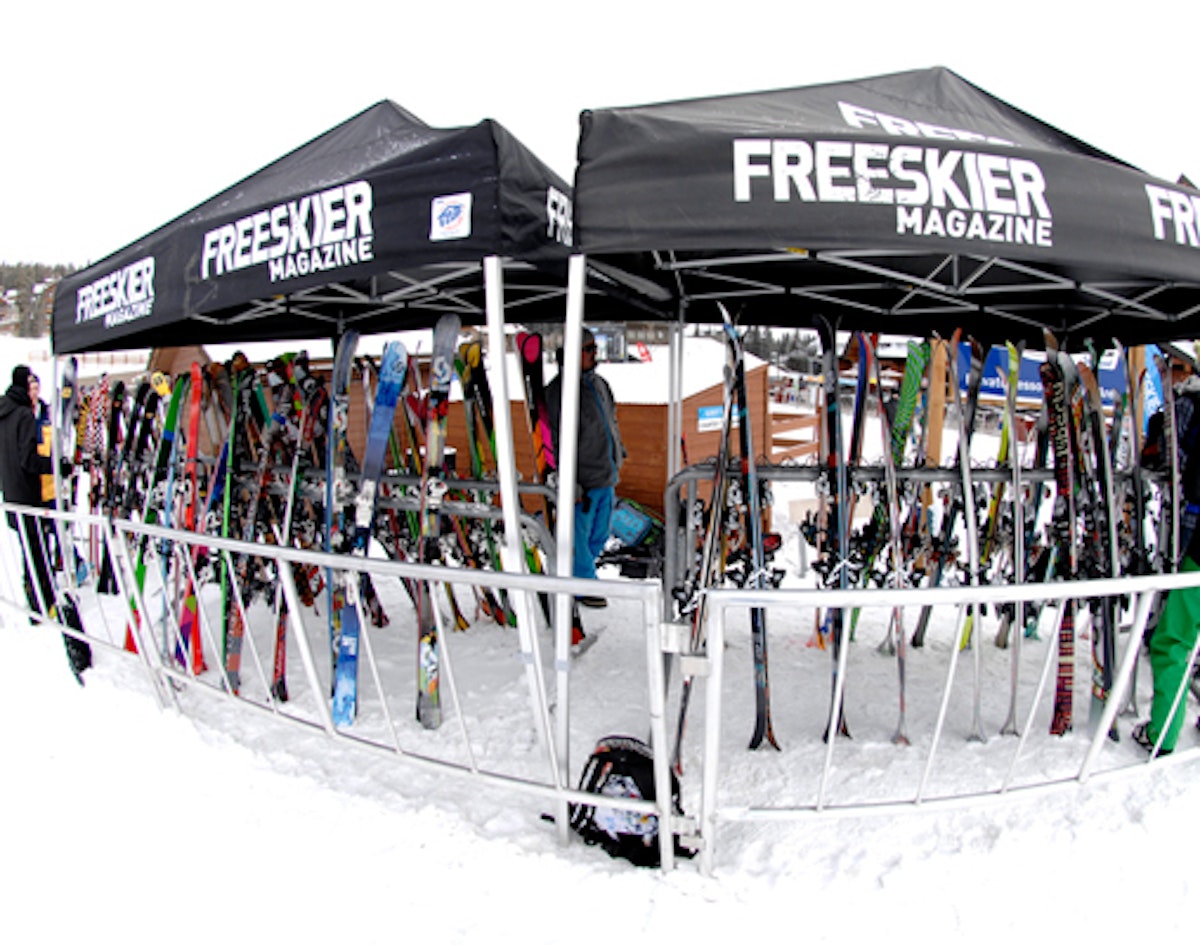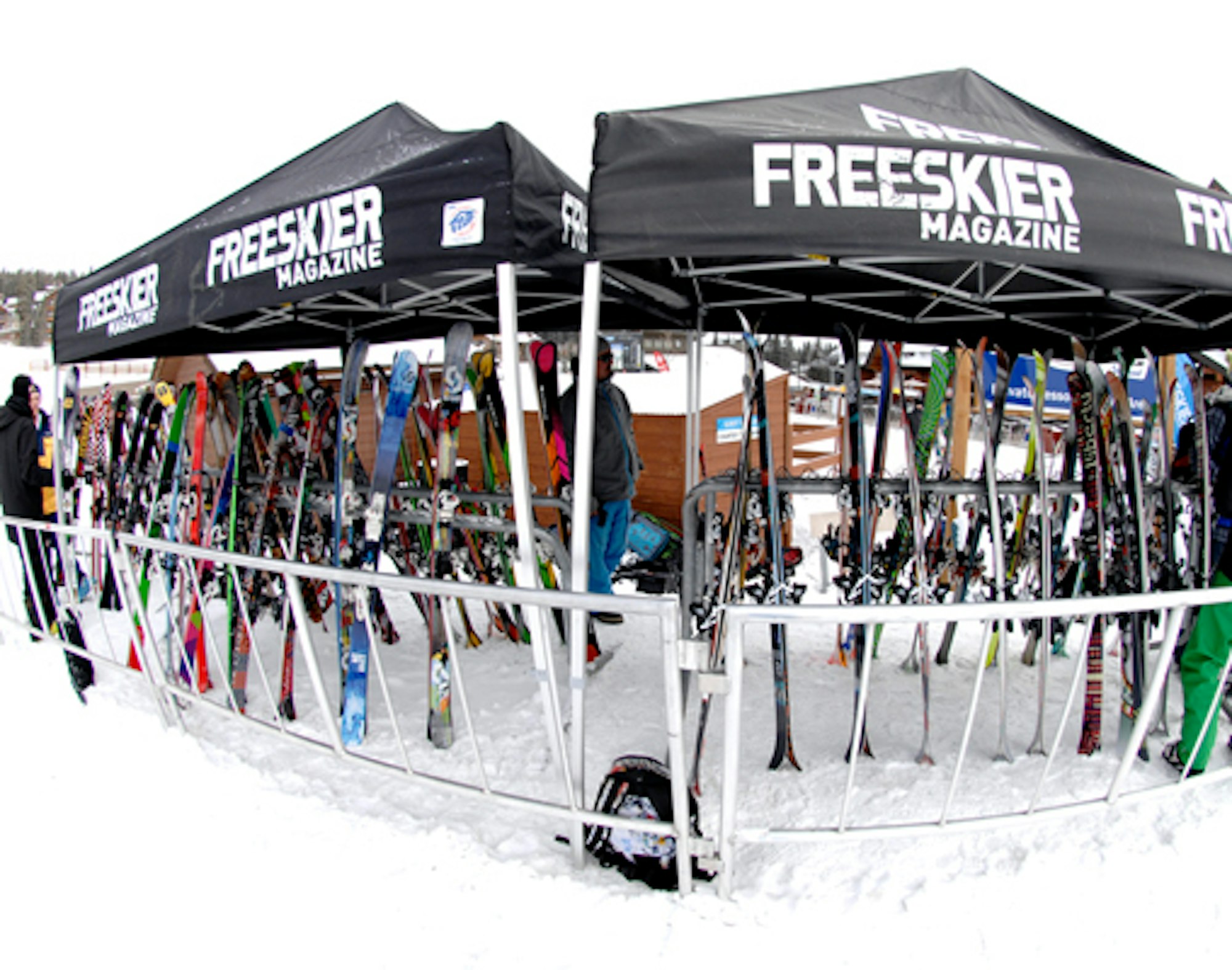For the third straight year, Freeskier hosted its annual park ski test on Peak 8 at Breckenridge Ski Resort, home to the Freeway and Park Lane terrain parks. If you’ve read about our Breckinvasion in previous Buyer’s Guides, you’ll need little introduction to these legendary stomping grounds. The story remains true: Breckenridge is an ideal venue—one of the few worthy spots in the country—for a ski test of this magnitude.
For five straight days, we erect our tents and load up the ski racks at the base of Chair 5, a double chair that serves as the gateway to Freeway and Park Lane. Freeway is home to jumps and rails of such enormous size that some skiers tremble in their boots at the thought of simply sliding through the park’s gates. Park Lane, on the other hand, boasts a plethora of small to midsized features packed in such great density that your head may begin to spin when you ponder the endless routes you could take. With this array of terrain it’s obvious why we’ve ranked Breck No. 1 for terrain parks, multiple years in a row.
For confirmation, just ask Breckenridge pro team rider, Bobby Brown, who is now a regular visitor to our park ski test. When asked why he calls Breckenridge home, the four-time X Games gold medalist explains, “The Breck parks have the best flow ever. If you want to ride mellow jumps and mellow rails, hit up Park Lane. On the next run, you can go over to Freeway and hit the biggest line of jumps anywhere in the world. Breck is always changing up the features and keeping things fresh.”
Behind the scenes: Freeskier’s 2014 Park Ski Test at Breck
The terrain parks we utilize in our testing endeavors share a common trait with the skis we test: some features change radically from year to year, but a winning formula benefits most from slight adjustments. Rails and jibs are welded and molded into different shapes and sizes. Jumps take new shape and may be relocated to new sections of a trail. Meanwhile, from garages to enormous factories, skis are pressed with tweaks to core ingredients, lengths, profiles and side cuts. Critiquing the enormous batch of ever-evolving skis presents an exciting challenge for our team of testers. They must dissect the nuances that separate a good ski from a great one.
What constitutes a great ski in this day and age? The answers vary as many seek a well-rounded model, while an increasing number of skiers gravitate towards a particular niche of the sport, requiring skis that excel in specific areas. Some have dreams of Olympic glory—focusing their energy exclusively on slopestyle or halfpipe. Some prefer skiing in the streets or taking their park mentality to the far reaches of the mountains, jibbing and bonking every natural hit in sight, while carving up a storm along the way. While many people designate themselves as belonging to one branch or another, our testers must account for and understand all styles. As such, they must ask of themselves: Who would like this ski? How would they use its features? What might that change about it?
Ski companies must also ask themselves similar questions. There are many decisions to be made behind the scenes and manufacturers spend countless hours and dollars on R&D before bringing a ski to market. They must decide what mix of core materials and new technologies will create a ski that will give them an edge over the competition and have you wanting to rep their brand.
In an effort to cater to the needs of skiing’s many subgroups, an increasing number of brands are bringing more specialized models to the test each year. Take Armada, for example, which has staples such as the AR7, but continues to introduce new skis like the Al Dente—with an extra-soft flex pattern in comparison to other park skis—suited to the buttery style of Henrik Harlaut. E-Dollo’s need for an ultra-soft ski echoes the desire of many skiers who are mimicking their hero’s moves. No nosebutter leading into that cork 7? Well, then it wasn’t that cool, dude.
Or look at Atomic, who reminds us that just because something is good doesn’t mean it can’t get better. Atomic took its Punx, an Editor’s Pick in each of the last three years, and completely redesigned it. A bold move, yes? One with the potential to jeopardize the ski’s coveted status. But it seems adapting to the ever-changing needs of skiers outweighs the risk. Atomic’s reward? Editor’s Pick status for the fourth straight year. Your reward? A ski that maintains its stability yet is more playful thanks to a restrained amount of tip and tail rocker.
Each brand has a similar story: their purpose is to make the best skis, and through that goal they also challenge our testers—for whom the Breck trial is a special opportunity to shred next year’s best sticks.
A challenge, perhaps, yet our highly-skilled ladies and gents, each with a vast knowledge of ski construction, are ready to accept the task with a grin from ear to ear. “I love seeing what the various companies are trying differently from year to year,” said longtime Freeskier ski tester, Grant Savidge. “What works, what doesn’t work … and also seeing what other testers are excited about. It’s always fun to see the differences of opinion.”
During the course of the week, we amassed thousands of scores and comments with that collective data serving as the basis for this year’s selections. Of course, we also enjoyed backflip contests, daily BBQ lunches, après at the T-Bar, rowdy family dinners at the condo, evenings out on the town and other forms of debauchery that aren’t quite fit for print. We digress…
So, which skis emerged as the crème de la crème? Follow this link and browse our Editor’s Picks—the best damn park skis of 2014.
Related: How we use technology to simplify ski testing



![[GIVEAWAY] Win a Head-to-Toe Ski Setup from IFSA](https://www.datocms-assets.com/163516/1765920344-ifsa.jpg?w=200&h=200&fit=crop)


![[GIVEAWAY] Win a Legendary Ski Trip with Icelantic's Road to the Rocks](https://www.datocms-assets.com/163516/1765233064-r2r26_freeskier_leaderboard1.jpg?auto=format&w=400&h=300&fit=crop&crop=faces,entropy)




![[GIVEAWAY] Win a Head-to-Toe Ski Setup from IFSA](https://www.datocms-assets.com/163516/1765920344-ifsa.jpg?auto=format&w=400&h=300&fit=crop&crop=faces,entropy)


